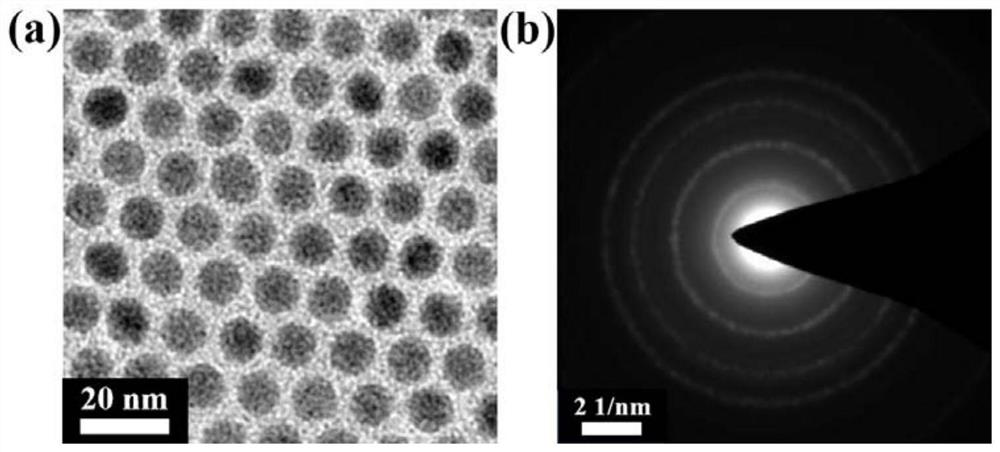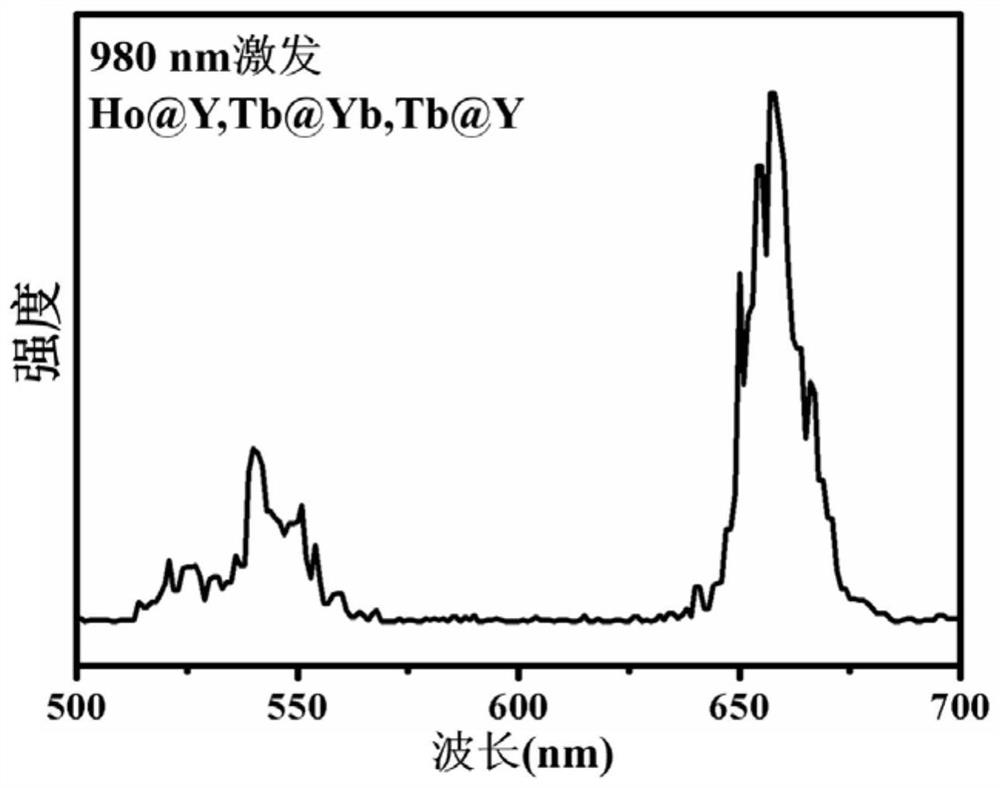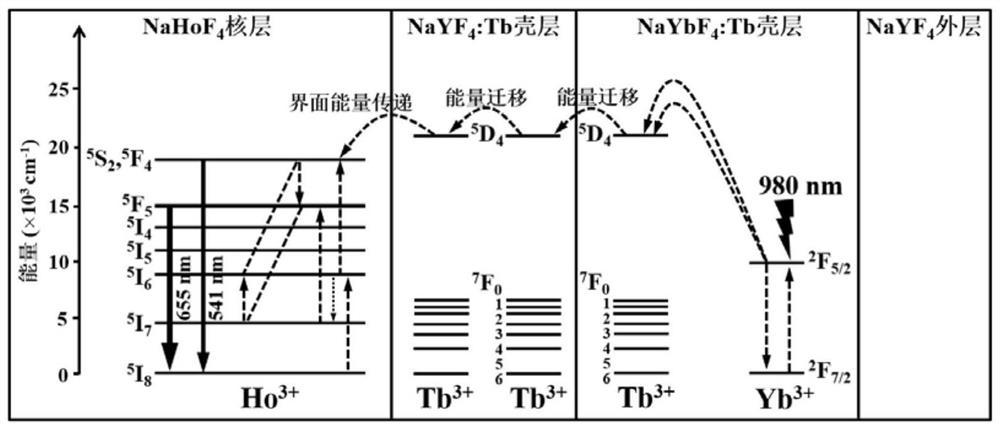A kind of terbium ion doped up-conversion nanomaterial and its preparation method
A nanomaterial and ion doping technology is applied in the field of terbium ion-doped Ho3+-based up-conversion nanomaterials and their preparation, which can solve the problems of limited biological application, fluorescence quenching, etc., and achieves short preparation period, low equipment cost, Simple preparation process
- Summary
- Abstract
- Description
- Claims
- Application Information
AI Technical Summary
Problems solved by technology
Method used
Image
Examples
Embodiment 1
[0075] This embodiment provides a NaHoF 4 @NaYF 4 :75%Tb@NaYbF 4 :30%Tb@NaYF 4 Preparation methods of upconversion nanomaterials.
[0076] (1)NaHoF 4 Nuclear layer preparation: put 15mL oleic acid and 20mL octadecene into a 100mL three-necked flask, mix and stir evenly. Then add 1mL concentration of 1mol L -1 Holmium chloride solution, mix and stir evenly, then raise the temperature to 105°C and keep it for 40min to remove water. Then the temperature was raised to 150°C and kept for 40 minutes to form a rare earth-oleic acid chelate. Then the temperature was naturally cooled to room temperature, 0.1 g of sodium hydroxide (2.5 mmol) and 0.148 g of ammonium fluoride (4 mmol) in methanol (10 mL in total) were added to the above mixture and stirred, then the temperature was raised to 90 °C and kept for 1 h , to remove excess methanol. Then, under the protection of argon, the temperature was raised to 280° C. for 1 h. Finally, the cloudy solution after the reaction was nat...
Embodiment 2
[0081] This embodiment provides a NaHoF 4 @NaYF 4 :73.5%Tb@NaYbF 4 :28.5%Tb@NaYF 4 Preparation methods of upconversion nanomaterials.
[0082] (1)NaHoF 4 Nuclear layer preparation: put 13.6mL oleic acid and 20mL octadecene into a 100mL three-necked flask, mix and stir evenly. Then add 1mL concentration of 1mol L -1 Holmium chloride solution, mix and stir evenly, then raise the temperature to 98°C and keep it for 40min to remove water. Then the temperature was raised to 148° C. and kept for 40 minutes to form a rare earth-oleic acid chelate. Then the temperature was naturally cooled to room temperature, 0.1 g of sodium hydroxide (2.5 mmol) and 0.148 g of ammonium fluoride (4 mmol) in methanol (10 mL in total) were added to the above mixture and stirred, then the temperature was raised to 88 °C and kept for 1 h , to remove excess methanol. Then, under the protection of argon, the temperature was raised to 278° C. for 1 h. Finally, the cloudy solution after the reaction wa...
Embodiment 3
[0087] This embodiment provides a NaHoF 4 @NaYF 4 :76.5%Tb@NaYbF 4 :31.5%Tb@NaYF 4 Preparation methods of upconversion nanomaterials.
[0088] (1)NaHoF 4 Nuclear layer preparation: put 16.4mL oleic acid and 20mL octadecene into a 100mL three-necked flask, mix and stir evenly. Then add 1mL concentration of 1mol L -1 Holmium chloride solution, mix and stir evenly, then raise the temperature to 112°C and keep it for 40min to remove water. Then the temperature was raised to 152° C. and kept for 40 minutes to form a rare earth-oleic acid chelate. Then the temperature was naturally cooled to room temperature, 0.1 g of sodium hydroxide (2.5 mmol) and 0.148 g of ammonium fluoride (4 mmol) in methanol (10 mL in total) were added to the above mixture and stirred, then the temperature was raised to 92 °C and kept for 1 h , to remove excess methanol. Then, under the protection of argon, the temperature was raised to 282° C. for 1 h. Finally, the cloudy solution after the reaction...
PUM
| Property | Measurement | Unit |
|---|---|---|
| particle diameter | aaaaa | aaaaa |
| size | aaaaa | aaaaa |
| particle diameter | aaaaa | aaaaa |
Abstract
Description
Claims
Application Information
 Login to View More
Login to View More - R&D
- Intellectual Property
- Life Sciences
- Materials
- Tech Scout
- Unparalleled Data Quality
- Higher Quality Content
- 60% Fewer Hallucinations
Browse by: Latest US Patents, China's latest patents, Technical Efficacy Thesaurus, Application Domain, Technology Topic, Popular Technical Reports.
© 2025 PatSnap. All rights reserved.Legal|Privacy policy|Modern Slavery Act Transparency Statement|Sitemap|About US| Contact US: help@patsnap.com



